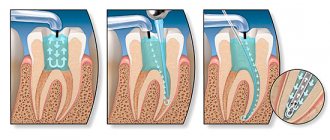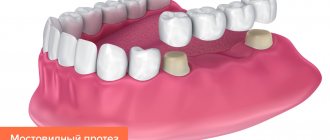From this article you will learn:
- what caries looks like under a microscope,
- about the reasons for its appearance,
- what caries leads to if left untreated.
Dental caries is a slowly occurring pathological process of destruction of hard dental tissues, developing with the participation of cariogenic bacteria in the composition of soft dental plaque. Insufficiently good oral hygiene leads to the accumulation of microbial plaque, bacteria in which metabolize food debris, turning them into organic acids. Upon contact with tooth enamel, acids dissolve its mineral matrix, which leads to “washing out” of calcium and gradual destruction of the enamel structure.
Thus, the onset of the carious process is associated with the appearance of foci of demineralization of tooth enamel, which look like white chalky spots. If the effect of organic acids continues, then this already leads to the formation of a chalky spot of a carious cavity in place - at first only in the surface defect to the depth of the enamel. In the absence of timely treatment, caries spreads to the dentin underlying the enamel. If the carious process is not treated at this stage, the infection from the carious cavity penetrates into the tooth pulp, first causing the development of pulpitis and then periodontitis.
What caries looks like: photo
However, it is worth saying that the risk of developing caries depends not only on the quality of oral hygiene. For example, there are individual characteristics inherent at the genetic level that make tooth enamel more resistant to acids. This is referred to as caries resistance, and its degree depends on the characteristics of the enamel structure in each person. The risk of caries development is also influenced by the individual characteristics of the oral fluid - the daily volume of saliva secretion, its buffer capacity (the ability to neutralize acids), and the concentration of lysozyme in it.
The development of caries is also influenced by another very important point, which concerns your eating behavior. For example, if you have the habit of snacking on chips, flour or sweets between main meals, the risk of caries becomes maximum even if the tooth enamel is highly caries-resistant. The same applies to frequent consumption of acidic and sugar-containing drinks, such as fruit juices or sweet soda. Accordingly, there are certain rules that a person must follow in order to reduce the risk of developing caries, and these rules apply not only to the normalization of oral hygiene. Read more about this in the article:
→ Prevention of caries development
Causes of caries development
There can be many reasons for the appearance of caries, but the main one is a violation of the acid-base balance in the oral cavity, which leads to the formation of plaque. Gradually, plaque, if not removed, accumulates, penetrating the inner layers of enamel and destroying the tooth.
In turn, a violation of this balance may have the following reasons:
- poor hygiene;
- an excess of sweet and overly fatty foods in the daily diet;
- insufficient intake of vitamins (including from fresh fruits and vegetables);
- poor quality of drinking water;
- consequences of diseases suffered in childhood (for example, rickets);
- diabetes;
- dysfunction of the thyroid gland;
- gastrointestinal diseases;
- general decrease in immunity.
The answer to the question: “Is it worth treating caries?” - unambiguous. It doesn’t just need to be treated: you need to see a doctor at the first sign of its appearance. Otherwise, advanced caries can lead to severe pain and eventual tooth loss.
Stages and symptoms
The destructive process of the hard layers of the tooth is a consequence of poor-quality oral care: soft plaque, including interdental spaces, contains not only food debris, but also microbes. The disease never appears suddenly: it takes time and a favorable environment to begin. Without treatment, it progresses, penetrating into the very depths of dental tissues, the lesions grow, capturing neighboring areas.
In development, caries passes sequentially from the initial to the deep forms, and for each of them the symptoms will be different.
Initial
The demineralization zone “white spot” is formed under the influence of organic acids - metabolites of food residues. Contacting the enamel, they destroy it, dissolving the mineral component and leading to calcium loss. A carious defect is manifested by loss of shine and the appearance of a rough spot. The enamel in this place is easily scraped off, exposing the defect.
There are no symptoms. In a clinical setting, diagnosis after professional cleaning is carried out with a dye solution. After washing off the liquid, the affected areas remain colored, clearly showing the extent of the problem. Healthy areas are not painted. Treatment is usually limited to enamel restoration procedures and is not difficult.
Superficial
Destruction of the upper enamel layer, carious lesions develop in place of white spots, without affecting other layers. The appearance of sensitivity to changes in the temperature and taste of food and drinks. Caries cavities have soft edges; under the mechanical influence of a sharp instrument, the enamel in this place easily chips.
Middle
The affected area increases in size, the dentin (the hard layer of the tooth behind the enamel) softens in the focal zone, which now covers this layer to the middle, not yet reaching the deep ones surrounding the pulp. It is filled with food debris and products of dental tissue destruction. Pain symptoms are rare and irregular, most often during eating. Usually the patient complains only about aesthetic problems: dark black spots, hollows, increased interdental spaces.
In a deep stage
Caries affects dentin throughout its entire depth, reaching almost to the very pulp (a collection of blood vessels and nerve endings), leaving only a thin layer before it. Pain occurs with hot and cold, sweet and sour, but quickly passes without the action of an irritant.
If the affected area is clogged with the remains of destroyed dental tissue, the pain syndrome may be weak and not felt at all, but when pressing on its bottom while chewing, it may intensify. The affected area is significant in size, but often has a small entrance, and a large cavity is located inside. When probing its bottom and in the area of the dentinal-enamel border, pain is also felt.
In addition to the degree of destruction, caries is distinguished by the degree of localization. If the caries lesion is located near the base (neck of the tooth), then it is called cervical. This form is more painful, and in severe cases leads to loosening and loss of teeth. When several fragments of the chewing row are simultaneously affected, surrounded by it like a ring, a particularly severe form is identified - circular. Its treatment is very complex and much more expensive than therapy for single organs.
Expert opinion. The progression of the disease is like the accumulation of a critical mass. In the early stages, it does not develop immediately, and a lot of time can pass from the spot stage to the surface stage. But the stronger the lesions, the faster the disease progresses. Once it has reached a deep form, an explosion can be expected at any moment - pulpitis and periodontitis.
Factors provoking the development of caries
In addition to the above reasons, caries can be caused by:
- anatomical features of the structure of teeth (congenital dimples in the enamel in which plaque accumulates);
- malocclusion (crooked teeth lead to the fact that even good toothpaste and a high-quality brush are not able to fully cope with cleansing);
- increased viscosity of saliva (renewal of microflora does not occur properly due to this, resulting in various diseases);
- a state of constant stress and increased nervousness (this leads to a deterioration in the absorption of microelements from food).
Treatment of dental caries and its features
The stage of development of carious formation directly affects the complexity of treatment.
- Caries in the spot stage, when areas of white and less often dark color are noticeable on the enamel, but the enamel itself is not damaged. A change in color indicates a loss of calcium in the area where the stain appeared. This is the simplest form of carious formation, which does not even require drilling. To correct the situation, a remineralization procedure is necessary - sometimes the patient can do it on his own at home.
- Superficial caries, in which the defect is located within the enamel layer, without affecting deeper layers. Here you cannot do without standard filling.
- Medium form, characterized by caries extending beyond the boundaries of the enamel and damage to the upper part of the dentin.
- Deep form , when the disease penetrates into the deep layers, sometimes involving the pulp. As a rule, it is accompanied by pain. This is the most advanced case, so a patient who did not go to the clinic on time and reached this stage will be forced to be treated in several stages. Treatment of deep caries requires separate consideration, as it is the most complex.
In addition, there is also bottle caries in children , the treatment of which has its own characteristics, since it affects only the upper incisors.
How quickly does caries develop?
The worse oral hygiene is, the more microbial plaque and food debris accumulates on the teeth. The rate of formation of carious defects directly depends on the regularity and quality of your oral hygiene, which should include not only the use of a toothbrush and paste, but also the regular use of dental floss to clean the interdental spaces. The rate of development of dental caries also depends on the composition of the microflora of the oral cavity and the factors that ensure caries resistance of tooth enamel.
In the development of the carious process, it is customary to distinguish 4 successive stages, each of which reflects the depth of carious damage to the hard tissues of the tooth. Some classifications also distinguish the so-called stage 5, called “complicated caries.” But in this case we are talking about complications (consequences of untreated caries) - pulpitis and periodontitis.
- The initial form of caries (Fig. 4) looks like a chalky stain on the surface of the tooth (over time, the chalky stain may darken). The enamel surface in the spot area is rough, there is no characteristic shine, but the carious cavity itself has not yet formed at this stage. White spots are areas of demineralization in which the enamel has lost a lot of calcium due to exposure to acids. This stage of caries is the only one reversible - with normalization of oral hygiene and a course of remineralization.
- Superficial form of caries (Fig. 5) - if exposure to microbial plaque and organic acids continues, then the framework of weakened enamel in areas of demineralization begins to collapse. Surface enamel defects appear, which are localized within the thickness of the enamel layer, i.e. destruction has not yet affected the dentin lying under the tooth enamel. Figure 5 clearly shows that surface carious defects are formed precisely against the background of foci of enamel demineralization (looking like white spots).
- Medium caries (Fig. 1-2) - if the tooth is not treated at the previous stage, then the carious process penetrates beyond the enamel-dentin border. With average caries, damage occurs to the superficial and middle layers of dentin (without the process spreading to the deep layers adjacent to the pulp of the tooth). It should be noted that dentin is much softer in hardness than enamel, and therefore, as soon as microbes overcome the enamel-dentin boundary, the rate of tooth destruction increases many times over.
- Deep form of caries (Fig. 3) - with deep caries, dentin is affected almost to its entire depth. The dental pulp (neurovascular bundle) is separated from the carious cavity only by a thin layer of healthy dentin. If at this stage the tooth is not cured in time, then cariogenic microorganisms will penetrate into the tooth pulp and cause inflammation in it (pulpitis) - with a characteristic severe pain syndrome.
You can read how each form of dental caries is treated by clicking on the appropriate links above. In each of the articles you will find not only photographs, but also a video of the procedure for preparing a tooth with a drill, as well as its subsequent filling.
How dental caries is treated with laser
In addition to the traditional treatment of caries, modern medicine offers an innovative method using a laser.
Using a laser you can:
- selectively remove affected tissue, preserving healthy tissue as much as possible;
- sterilize the canals, which is necessary in the treatment of pulpitis.
Among the advantages of the laser:
- high quality of treatment;
- no pain;
- longevity of the results obtained;
- complete safety for the patient;
- no discomfort during the treatment process.
The laser allows you to achieve the formation of a completely sterile cavity and avoid chips and cracks, which often happens when using a drill. The surface of the tooth becomes like pumice, which has a positive effect on the properties of the materials used for filling.
Methods for diagnosing initial caries
A lesion can be identified using several basic diagnostic methods:
- Teeth staining.
This is the most common method using a methylene blue solution, as well as a special tool called a caries detector. When applied, these substances can turn the affected areas pink.
- Drying.
One of the diagnostic methods is drying the teeth. First, they are treated with hydrogen peroxide, then dried using cotton swabs and warm air. Such manipulations make it possible to detect even minor stains on the teeth.
- UFO-stomatoscopy.
Before the procedure begins, the teeth are cleaned of plaque, which allows the specialist to determine the location of the destructive process.
- Radiography.
This technique is most often used for contact caries. In the photographs, the affected areas appear as small spots.
How caries is treated with the ICON system
This is another modern technology that allows minimal use of medical instruments: in rare cases, the doctor uses a drill, but in most situations it is possible to use a hand instrument, which preserves the maximum possible volume of natural tooth tissue.
In addition, the ICON system has the following advantages:
- no need for pain relief;
- healthy dentin is not damaged during treatment;
- the procedure lasts no more than 45 minutes, there are no age restrictions.
How to treat dental caries using the ICON system:
- soft tissues are isolated with a rubber dam;
- the affected area is treated with a special gel;
- the carious area is cleaned with a medical instrument;
- a gel is applied, popularly called a “liquid filling”;
- the composition is fixed using ultraviolet light;
- The surface of the tooth is polished.
But the procedure also has a minus, otherwise it would be used everywhere: this method can only be used at the initial stage of caries development, but for deeper lesions you cannot do without a drill.
Causes of dental diseases in humans
The main cause of dental diseases is the activity of bacteria, which results in caries. But there are other factors that affect oral health:
- heredity and genetic pathologies;
- quality of drinking water;
- ecology of the urban environment;
- nutritional features;
- professional activity.
In most cases, it is impossible to change anything from this list. Therefore, it is important to at least be able to promptly recognize the symptoms of dental disease and consult a doctor as soon as possible to avoid complications.
Treatment of caries on baby teeth
Many parents, having noticed caries on their child’s baby teeth, believe that nothing needs to be done - these teeth will fall out anyway. However, such a decision is explained by ignorance: not every person knows what kind of caries is treated in modern dental clinics.
When visiting a doctor, a child undergoes:
- ozone therapy is a modern method using a powerful jet of ozone used for antibacterial treatment;
- infiltration is a method in many ways similar to ICON, but a filling is not installed (the doctor is limited to isolating the cavity);
- abrasive cleaning - the method is suitable for the initial stage of caries, has many similarities with professional cleaning of the oral cavity;
- silvering - the enamel is coated with a solution of silver diamine, which disinfects the surface. The method is rarely used due to its low aesthetic appeal - teeth remain black until they fall out;
- Conservative treatment for more serious lesions, accompanied by pain relief.
The use of a microscope in surgical dentistry
The microscope is also effective during surgical operations.
The use of a dental microscope makes it possible to make surgery minimally invasive, since it becomes possible to use microinstruments specially designed for microscopic dentistry, which are significantly smaller in size compared to traditional ones, and therefore cause less damage to oral tissue. Patients tolerate both the operation itself and the postoperative period more easily.
Treatment of average caries in stages
Step-by-step treatment of caries includes the following steps:
- Cleaning the surface from plaque . How are caries treated in dentistry? First, be sure to clean the damaged tooth and the teeth adjacent to it. To remove plaque, the dentist can use an abrasive brush or floss; to remove the stone, ultrasonic attachments will be required.
- Drilling out affected tissues . Since enamel is hard and durable, it is destroyed less than dentin. It is for this reason that the entrance hole of the cavity may be small, expanding as it deepens. If cervical caries occurs, how to treat it? The doctor drills the edges of the enamel and removes dentin affected by caries. If even a small area of affected tissue remains, on top of which a filling is placed, this is fraught with problems in the very near future, because caries will begin to develop rapidly, which can ultimately lead to pulpitis.
- Isolating the tooth from moisture and saliva . Unfortunately, some dentists (in fact, most of them) neglect this point and skip it. When carious tissue is eliminated, the doctor, in preparation for filling, must isolate the tooth from contact with saliva. It might seem like a small thing, but it affects how long the filling will last. For a long time, ordinary cotton wool or gauze was used for isolation, which was used to cover the tooth, but this method was found to be ineffective. Modern dentistry recommends the use of rubber dam - a thin latex material in which holes are made. Its installation is quite labor-intensive, so dentists avoid this procedure in order to save their own time. The use of a rubber dam by a doctor is a sign that the dentist is conscientious about his work, putting the patient’s health above the profit received.
- Treatment of the cavity with antiseptics.
- Recreating the side wall . How is caries treated if it has affected the surface of the tooth in contact with another tooth nearby? Then you will need to install matrices and wedges to restore the side wall. The procedure cannot be called simple.
- Using acid to condition enamel . To ensure that the adhesive material applied to dentin penetrates into the deep tissues, phosphoric acid is used. At the end of the procedure, the gel must be completely washed off and the surface dried.
- Treatment of enamel with adhesive . In order to ensure ideal fastening of the filling, the enamel is thoroughly impregnated with adhesive material, and after its absorption, it is illuminated with a polymerization lamp.
- Installing a gasket for a seal . A gasket made of a special material is placed at the bottom of the drilled cavity. The need for this action is explained by the peculiarity of the shrinkage mechanisms of the filling material.
- Direct filling , restoring chewing function and aesthetic appearance. To do this, photopolymer materials are laid layer by layer, with each layer illuminated by a lamp, which gives greater strength.
- Surface grinding and polishing . Immediately after installation, the filling is uneven, as a result of which it not only causes a feeling of discomfort, but can even damage the tongue. Polishing will make the tooth smooth.
For many people, it is important not only to undergo caries treatment in Krasnodar, getting rid of pain and discomfort, but also to look attractive. Therefore, the dentist selects the filling material by color, trying to achieve 100% shade similarity with the natural tissue of neighboring teeth. The doctor’s task is to make sure that the filling does not stand out from the rest of the teeth, which is especially important when smiling.
Is it possible to treat caries on the front teeth without pain? Absolutely yes. Long gone are the days when going to the dentist and the treatment process was accompanied by physical suffering. Modern means of anesthesia make it possible for the patient to feel nothing at all. The anesthesiologist is able to select the concentration of the anesthetic so that it will act for several hours. The only unpleasant moment is the insertion of a needle into the gum: the faster the drug enters the tissue, the more painful it is for the patient. Although much here depends on the characteristics of the nervous system of each individual person. For people with a high pain threshold, going to the dentist can be an enjoyable experience.
Treatment of caries in the spot stage
There are several treatment methods for the initial stage.
- Treatment with solutions of calcium and sodium - the Borovsky-Leus method. This method of combating incipient caries was very common several years ago; today it is used less frequently, primarily due to its toxicity. The technique includes cleaning the tooth from plaque using a professional abrasive paste, treating it with hydrogen peroxide and special solutions. First, use a solution of calcium gluconate, and then make lotions with a solution of sodium fluoride. You need to repeat the procedure 15-20 times. It is advisable to treat the tooth every other day.
- Gel applications. Damaged teeth are cleaned, after which a special heated gel containing agar-agar and sodium fluoride is applied to them. It hardens on the teeth in the form of a film and saturates the enamel with minerals. The course of treatment includes 5 applications. Recently it has also been used infrequently.
- The use of special calcium phosphate-containing gels, fluoride-containing varnishes (fluoride varnishes) and other preparations for remineralization of enamel.
- Filling. The dentist cleans the tooth surface from plaque, prepares the enamel by drilling, isolates the tooth from saliva, applies acid and a special adhesive to ensure reliable adhesion of the tooth surface to the filling, and only then fills the tooth and grinds the filling.
In addition, the dentist teaches the patient proper oral hygiene: he tells how to properly care for his teeth, how to clean them and how to eat. And he strongly recommends visiting the dental clinic in a few months.
Preventive measures against caries
Any disease is easier to prevent than to treat, and caries is no exception in this regard.
To avoid its appearance, you need to:
- brush your teeth twice a day for 2 minutes;
- do not use toothpicks - special dental floss is more suitable for high-quality cleaning;
- use an irrigator or mouthwash;
- get rid of bad habits (smoking and drinking alcohol provoke deterioration of the oral cavity);
- eat more calcium in food;
- Get checked by a dentist at least once a year, but it’s better to do it more often.
| We must not forget that the main reason for the formation and development of caries is lack of hygiene. Therefore, prevention is extremely important, which consists of regular high-quality brushing of teeth after each meal. |
What can cause caries
There are several suggestions, for example, that tooth decay is transmitted genetically or that lack of hygiene contributes to the development of the disease. All this is true, but does not give the complete picture.
Where a person lives can also influence the occurrence of caries, namely the quality of water in that area.
Nutrition plays an important role in the prevention of caries. There are scientific studies confirming that eating fresh vegetables, greens and foods rich in proteins helps prevent tooth decay. That is, those people who like to chew raw carrots are less susceptible to dental diseases. That's why you should eat meat and a lot of raw vegetables - this is not only smart advice from nutritionists, but sound prevention in the fight against the development of dental caries.









